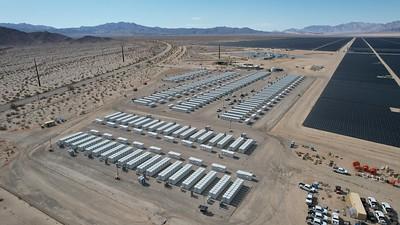BLM announces Sunlight Storage II Battery System is fully operational
Organization:
BLM Office:
Media Contact:
PALM SPRINGS, Calif. — The Bureau of Land Management today announced that the Sunlight Storage II Battery Energy Storage System is now fully operational. The battery energy storage system adds an additional 300 megawatts (MW) of energy storage to the Desert Sunlight Solar Farm in eastern Riverside County, bringing the total energy storage capacity of the project to 530 MW. The new project component allows solar energy to be stored and then released when the power is needed most, increasing the reliability and availability of clean energy on the state grid.
The Interior Department recently announced that it has now permitted more than 25 gigawatts of clean energy projects – surpassing a major milestone ahead of 2025 – enough clean energy to power more than 12 million homes across the country. This includes solar, wind and geothermal projects, as well as gen-tie lines on public lands that are essential for connecting clean electricity projects on both federal and non-federal land to the grid.
“BLM-managed public lands play a critical role in the clean energy transition,” said California Desert District Manager Shelly Lynch. “The demand for renewable energy has never been greater and Sunlight Storage II contributes to a robust and sustainable clean energy economy.”
The battery storage system is in an area analyzed and identified as suitable for renewable energy development as part of Desert Renewable Energy Conservation Plan Land Use Plan Amendment. The Desert Renewable Energy Conservation Plan is a landscape-level plan focused on 10.8 million acres of public lands in the desert regions of seven California counties that streamlines renewable energy development while conserving unique and valuable desert ecosystems and providing outdoor recreation opportunities. To approve these sites for renewable energy projects, the Department of the Interior and the BLM work with Tribal governments, local communities, state regulators, industry, and other federal agencies.
Additional information is available at the BLM National NEPA Register.
The BLM manages vast stretches of public lands that have the potential to make significant contributions to the nation’s renewable energy portfolio. To promote the development of these energy sources, the BLM provides sites for environmentally sound development of renewable energy on public lands. The efficient deployment of renewable energy from our nation’s public lands is crucial in achieving the Biden-Harris administration’s goal of a carbon pollution-free power sector by 2035. Recently, the Department of the Interior announced that BLM had achieved the major milestone of permitting 25 gigawatts of clean energy projects on public lands, including solar, wind, geothermal, and gen-ties (transmission lines that cross public lands to connect renewable energy projects on private lands to the grid).
The BLM manages about 245 million acres of public land located primarily in 12 western states, including Alaska, on behalf of the American people. The BLM also administers 700 million acres of sub-surface mineral estate throughout the nation. Our mission is to sustain the health, diversity, and productivity of America’s public lands for the use and enjoyment of present and future generations.

